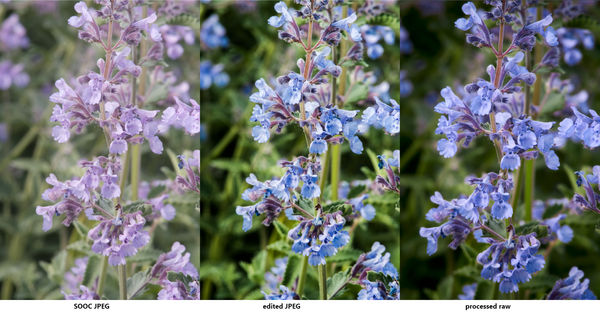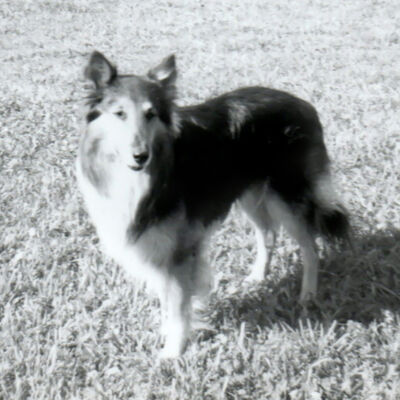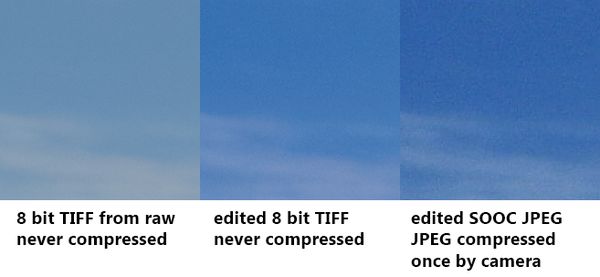Get it right vs fix it in post...
Apr 27, 2021 18:53:54 #
BigDaddy wrote:
Well, that, and billions of fantastic images all o... (show quote)
My dude, I told you I was out. You win. Your chest is puffier and your T-shirt far brighter. Besides, who could possibly hope to compete with an intellect capable of knowing how billions of photographs were captured, edited, and saved. 🤣
Apr 27, 2021 20:55:43 #
Ysarex
Loc: St. Louis
Fotoartist wrote:
I don't buy it. No high resolution JPEG from a 12MP camera looks that bad. And what kind of test would show a "processed' and "edited" image without divulging the process?
So here's basically the same thing with one of my current cameras -- 24 megapixel APS-C sensor (Fuji X-T2).
It shows the same thing only I had to enlarger an image section 300% instead of 200%.
The first illustration is to show what needed done. The photo is of my wife's nepeta (catnip) and the SOOC JPEG is too light (I expose for raws) and way off color as those flowers are blue -- auto white balance fail. I added the processed raw for reference but I didn't try hard to duplicate it when editing the JPEG. I just loaded the JPEG into PS and primarily used the Camera Raw Filter to move the image in the right direction.
The 2nd illustration is a patch of the plant at 300%. What we want to see is the damage caused by editing the JPEG. In the original compression to create the JPEG the algorithm identifies pixels it can make redundant by making them the same as other pixels. If the algorithm places too many of the same pixels together (it does) then they can be exposed, exaggerated when tone/color changes of consequence are applied to the JPEG. That embedded compression grid starts to become visible in the image.
As I previously noted this is less and less of a problem not because it doesn't happen -- it always happens -- but because we've swamped it with increasing resolution so we don't see it. The original point was to let JD750 understand what's happening and why. Hope this makes you happier.
Apr 27, 2021 22:48:15 #
srt101fan wrote:
I agree with your view on cropping. Why should you be constrained by the sensor's geometry....
The purists insist on "proper" framing using the "right" lenses and/or proper positioning of the camera with respect to the subject. That's not always possible.
And with some shots you might have "pictures within a picture" that are worth playing with.
The purists insist on "proper" framing using the "right" lenses and/or proper positioning of the camera with respect to the subject. That's not always possible.
And with some shots you might have "pictures within a picture" that are worth playing with.
I always take my photos with cropping in mind. If you frame the picture to the frame in your camera (Usually 4x6 size) then enlargements are nearly impossible. Making sure that you have more than enough extra in the frame makes it possible to make an 8x10 out of the 4x6 frame size. Then you crop the picture to 4x6 or 5x7 or 8x10 or even 8.5" x11 full page print. If you have a camera of AT LEAST 18 megapixels, then cropping should not be a problem. Most current DSLR's have at least 18 megapixels. The older ones such as the Cannon 10D, 20D, 30D etc. early Rebel cameras as well as the other brands early DSLR's had only a 6 or 8 megapixel sensor. These lower megapixel cameras would begin pixelization when cropping and would lose quality. With todays newer higher megapixel cameras, you can crop several decent quality pictures from the same shot without too much degradation to the picture. Of course if you are wanting a WALL-SIZED print, then the cropped photos will not work well... but most of us do not print that large of picture. Usually there is no need to print anything larger than a FULL PAGE 8.5" x 11" Print unless you are on a very special professional PAID job. Basically, do what works for you and your tastes, but do a lot of experimentation and get a lot of on the job training ... as well as listen to what more experienced photographers tell you... but what works for one photographer may not work for another one.
Apr 28, 2021 05:59:36 #
Ysarex wrote:
So here's basically the same thing with one of my current cameras -- 24 megapixel APS-C sensor (Fuji X-T2). ...
As I previously noted this is less and less of a problem not because it doesn't happen -- it always happens. ...
As I previously noted this is less and less of a problem not because it doesn't happen -- it always happens. ...
Although you have shown that JPEG compression can generate artifacts in the result (who didn't know that?) you didn't mention what kind of editing you did to the JPEG and how much compression you used. It's easy to show artifacts if you use a lot of compression (thumb on the scale).
Here is an example using a Fuji X100T (16 MP) that anyone can inspect at any magnification. It shows very little degradation if you don't compress the JPEG too much.
I don't recall how much compression I used when saving #2 but it the result was smaller than the SOOC version (#1) and larger than either of the two editd JPEGs (#3 and #4) which were saved from Picture Window Pro at a compression setting of 95 (from a range of 0-100).
If you have to go this far to prove a point maybe you have gone too far.
1. JPEG SOOC 8.043 MB

(Download)
2. From raw with Capture One 5.040 MB

(Download)
3. #2 leveled 3.433 MB

(Download)
4. #1 leveled and brightened

(Download)
Apr 28, 2021 08:51:01 #
Ysarex
Loc: St. Louis
selmslie wrote:
Although you have shown that JPEG compression can generate artifacts in the result (who didn't know that?) you didn't mention what kind of editing you did to the JPEG and how much compression you used.
In fact I did.
selmslie wrote:
It's easy to show artifacts if you use a lot of compression (thumb on the scale).
Which is why I said I used the highest quality (12) setting PS provides. When using the SOOC JPEG the camera sets the quality level. In the two examples I used the cameras provided no choice.
Apr 28, 2021 09:08:13 #
IGBTQ2 wrote:
My dude, I told you I was out. You win. Your chest is puffier and your T-shirt far brighter. Besides, who could possibly hope to compete with an intellect capable of knowing how billions of photographs were captured, edited, and saved. 🤣
Yes, you said you were out, you lied.
Your ad hominem attacks w/o addressing any of the raised issues, or your lame statements, says it all.
You were "out" from the get go!
Apr 28, 2021 09:30:39 #
Ysarex wrote:
Which is why I said I used the highest quality (12) setting PS provides. When using the SOOC JPEG the camera sets the quality level. In the two examples I used the cameras provided no choice.
How about an image with no JPEG compression at all?
If you download the attached image (I had to crop it from the 42MB original) and then view it at 300% you will also see the same kinds of artifacts that you showed. They are not JPEG artifacts and they have nothing to do with the compression grid because it never existed in the first place.
On the other hand, the problem may originate with the X-Trans sensor whose pattern repeats as a 6x6 square (20 green, 8 red and 8 blue). A Bayer array is much simpler and its pattern repeats as a 2x2 square (2 green, 1 red and 1 blue).
The problem is the 300% enlargement.
Apr 28, 2021 09:38:09 #
BigDaddy wrote:
You are correct that it becomes a question of standards or tolerance and how the image is used. That's exactly why shooting raw all the time is overkill for most photography done today.
Nor have you.
Millions, if not billions of spectacular images shot and edited as jpgs before raw was even available proves that raw is not a requirement for taking or editing great pictures. Even today, only a handful of people shoot 100% raw, most people can't be bothered, and some shoot raw only when they think it might be best in specific circumstances.
BigDaddy wrote:
The world is packed with fantastic images shot as jpgs, and edited as jpgs. And whilst I'm at it, shot in auto white balance with no one but you claiming to notice...
My search of the topic shows the overwhelming majority shoot with auto white balance, and only you seem to notice.
My "competence" is sufficient to give me lots of enjoyment, and has no effect on the subsidence of my arguments. Attacking a photo I made 10 or 20 years ago, or even yesterday is meaningless to the arguments put forth. If it were, I'd certainly be pointing out some of the stuff you've posted.
You are correct that it becomes a question of standards or tolerance and how the image is used. That's exactly why shooting raw all the time is overkill for most photography done today.
Ysarex wrote:
For you. You have not been elected a spokesperson for everyone.
Nor have you.
Millions, if not billions of spectacular images shot and edited as jpgs before raw was even available proves that raw is not a requirement for taking or editing great pictures. Even today, only a handful of people shoot 100% raw, most people can't be bothered, and some shoot raw only when they think it might be best in specific circumstances.
BigDaddy wrote:
The world is packed with fantastic images shot as jpgs, and edited as jpgs. And whilst I'm at it, shot in auto white balance with no one but you claiming to notice...
Ysarex wrote:
If you search the topic you'll find many people notice. Your exaggerations align with your incompetence.
If you search the topic you'll find many people notice. Your exaggerations align with your incompetence.
My search of the topic shows the overwhelming majority shoot with auto white balance, and only you seem to notice.
My "competence" is sufficient to give me lots of enjoyment, and has no effect on the subsidence of my arguments. Attacking a photo I made 10 or 20 years ago, or even yesterday is meaningless to the arguments put forth. If it were, I'd certainly be pointing out some of the stuff you've posted.
Apr 28, 2021 09:41:17 #
Ysarex
Loc: St. Louis
selmslie wrote:
How about an image with no JPEG compression at all... (show quote)
Which is why I showed a side by side comparison. Which is why I did say that in this venue it was difficult to show what happens. Are you saying editing a JPEG doesn't create unique artifacts that result from the embedded compression grid interacting with the edit changes? If you are saying that you're wrong.
Apr 28, 2021 09:55:02 #
Ysarex wrote:
Which is why I showed a side by side comparison. Which is why I did say that in this venue it was difficult to show what happens. Are you saying editing a JPEG doesn't create unique artifacts that result from the embedded compression grid interacting with the edit changes? If you are saying that you're wrong.
I have always said that editing an 8-bit image can create artifacts.
Bit it doesn't have to be a JPEG. It does the same thing to an 8-bit TIFF. Since there is no compression grid in a TIFF, that's not the culprit.
300% magnification (extreme pixel peeping) can reveal these issues.
But it's also possible that the X-Trans sensor plays a part. If you want to look into that, knock yourself out.
Apr 28, 2021 10:03:07 #
Ysarex
Loc: St. Louis
selmslie wrote:
I have always said that editing an 8-bit image can create artifacts.
I never disagreed with that. I've always said that too.
selmslie wrote:
Bit it doesn't have to be a JPEG. It does the same thing to an 8-bit TIFF. Since there is no compression grid in a TIFF, that's not the culprit.
You are wrong about that. It is not the only culprit but it is unique to editing JPEGs and it creates a unique type of degradation. As noted it can be difficult in this venue to demonstrate.
Apr 28, 2021 10:32:55 #
Ysarex wrote:
You are wrong about that. It is not the only culprit but it is unique to editing JPEGs and it creates a unique type of degradation. As noted it can be difficult in this venue to demonstrate.
It is apparently impossible for you to demonstrate this here, even at 300%.
So far you have been unable to separate the artifacts related to the compression grid from those caused by editing an 8-bit image.
If you can't do that you should probably consider that the artifacts you are seeing have a different cause unrelated to the compression grid.
Apr 28, 2021 10:58:02 #
Ysarex
Loc: St. Louis
selmslie wrote:
It is apparently impossible for you to demonstrate this here, even at 300%.
So far you have been unable to separate the artifacts related to the compression grid from those caused by editing an 8-bit image.
So far you have been unable to separate the artifacts related to the compression grid from those caused by editing an 8-bit image.
I showed the unique JPEG degradation with my first example using a 12 megapixel camera. https://www.uglyhedgehog.com/t-694192-23.html#12196221 I just didn't include 8 bit editing as a separate issue. But happy to do that just for you.
I took the raw file and created an 8 bit TIFF similar to the SOOC JPEG with similar problems (flat, off color, too light). I then edited that 8 bit TIFF in PS (mostly Camera Raw Filter) to address those problems. No lossy compression ever applied. As expected there's some degradation that results from editing and from editing an 8 bit image.
However the degradation at 100% (first illustration below) is visibly different than what we see from editing the SOOC JPEG. In the edit of the SOOC JPEG there are unique artifacts created in which you can begin to see the actual compression grid cells. You can see sides and corners of grid cells and that is not at all apparent in the edited 8 bit TIFF.
The reason I originally mentioned this specific type of degradation is because it is unique to JPEG as opposed to for example editing 8 bit files which creates problems regardless of the presence of lossy compression. And one more time: as I've previously noted this becomes less and less of a problem as we swamp it under higher and higher resolution cameras.
Illustrations below are PNG files which means the TIFF samples have never been lossy compressed and the only lossy compression is the original JPEG compression from the camera. (2nd illustration at 200%).
Apr 28, 2021 11:10:36 #
Ysarex
Loc: St. Louis
BigDaddy wrote:
My search of the topic shows the overwhelming majority shoot with auto white balance, and only you seem to notice.
My search of the topic shows the overwhelming majority shoot with auto white balance, and only you seem to notice.
https://www.colesclassroom.com/6-reasons-auto-white-balance-is-not-your-bff/
https://fstoppers.com/education/never-trust-auto-white-balance-your-photography-349671
https://www.peachpit.com/articles/article.aspx?p=2447541&seqNum=3
https://photo.stackexchange.com/questions/97316/wrong-in-camera-auto-white-balance-issue
https://photonaturalist.com/why-you-shouldnt-rely-on-auto-white-balance/
https://www.fuji-x-forum.com/topic/4301-problems-with-auto-white-balance/
https://www.fujix-forum.com/threads/problems-with-auto-whitebalance.78974/
https://www.fujix-forum.com/threads/white-balance-problems.105760/
https://skylum.com/blog/fixing-color-balance-issues-in-luminar
https://www.scantips.com/lights/whitebalance.html
https://www.pentaxforums.com/forums/6-pentax-dslr-discussion/386003-k5iis-auto-white-balance-problem.html
Obviously I'm not the only one who notices. You remain clueless. Let me know if you'd like some help with how to do a search.
Apr 28, 2021 11:17:29 #
Ysarex wrote:
The SOOC JPEG is from an older compact camera -- S... (show quote)
Well, thanks for showing what you did and doing all the work. I appreciate the amount of time and effort you put into it.
For myself, I must say my Nikon D3, a 12MP camera shoots JPEGS that are pristine and impressive. But everyone doesn't have a 12MP D3. So what you are saying in general is probably good advice.
If you want to reply, then register here. Registration is free and your account is created instantly, so you can post right away.








